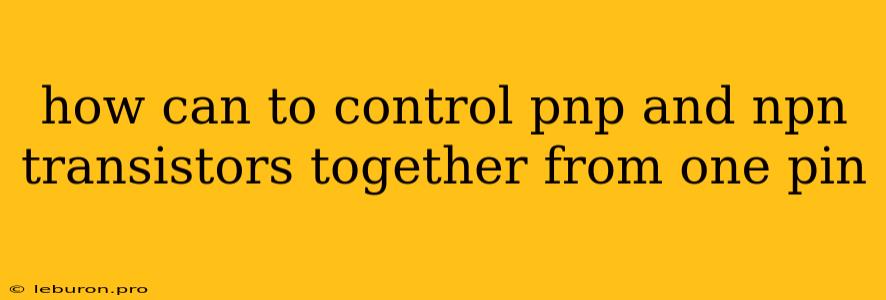Controlling both PNP and NPN transistors from a single pin requires understanding the unique characteristics of each transistor type and the interplay of their configurations. This task, though challenging, can be achieved through creative circuit design and an understanding of the principles behind transistor operation. This article will delve into the methods and considerations for using a single pin to control both a PNP and an NPN transistor, focusing on the underlying principles, practical applications, and common configurations.
Understanding Transistor Basics:
Before diving into the control strategies, it's crucial to grasp the fundamentals of PNP and NPN transistors. These are three-terminal semiconductor devices acting as electronic switches or amplifiers.
NPN Transistors:
- Structure: An NPN transistor consists of a thin layer of P-type semiconductor sandwiched between two N-type semiconductors.
- Operation: The base terminal (the middle layer) controls the current flow between the collector and emitter terminals. A small current at the base allows a much larger current to flow from the collector to the emitter.
- Control: An NPN transistor turns ON when a positive voltage is applied to the base with respect to the emitter.
PNP Transistors:
- Structure: A PNP transistor consists of an N-type semiconductor sandwiched between two P-type semiconductors.
- Operation: The base terminal (the middle layer) controls the current flow between the collector and emitter terminals. A small current at the base allows a much larger current to flow from the emitter to the collector.
- Control: A PNP transistor turns ON when a negative voltage is applied to the base with respect to the emitter.
Methods for Controlling PNP and NPN Transistors Together:
1. Complementary Pair Configuration:
This configuration utilizes one PNP and one NPN transistor connected in a complementary arrangement to control the flow of current through a common load. The circuit typically uses a single control signal, either a positive or negative voltage, to switch the transistors ON and OFF.
a) Working Principle:
- When a positive voltage is applied to the control pin, the NPN transistor turns ON, allowing current to flow through the load. The PNP transistor remains OFF because the base voltage is lower than the emitter voltage.
- When a negative voltage is applied to the control pin, the PNP transistor turns ON, allowing current to flow through the load. The NPN transistor remains OFF because the base voltage is lower than the emitter voltage.
b) Circuit Diagram:
[Insert circuit diagram of a complementary pair configuration]
c) Applications:
- This configuration is often used in push-pull amplifiers and other applications where a bipolar output signal is required.
2. Darlington Pair Configuration:
This configuration uses two transistors, typically both NPN or both PNP, connected in a way that amplifies the current gain of the overall circuit. It provides a higher current gain and faster switching speed than a single transistor.
a) Working Principle:
- When a positive voltage is applied to the control pin of the first transistor, it turns ON and allows current to flow to the base of the second transistor. This current amplifies through the second transistor, leading to a much larger current flowing through the load.
- When the control pin is low, the first transistor turns OFF, stopping the current flow to the second transistor. This cuts off the current flow through the load.
b) Circuit Diagram:
[Insert circuit diagram of a Darlington pair configuration]
c) Applications:
- Darlington pairs are commonly used in high-current applications, such as motor control and power switching.
3. Common Emitter Configuration with a Logic Level MOSFET:
This method utilizes the inherent voltage-controlled nature of MOSFETs to control both PNP and NPN transistors. A logic-level MOSFET acts as a switch, controlled by a digital signal from a microcontroller or logic gate.
a) Working Principle:
- When the MOSFET is turned ON by a high digital signal, it acts as a closed switch, allowing current to flow from the control pin to the base of both transistors.
- When the MOSFET is turned OFF by a low digital signal, it acts as an open switch, interrupting the current flow to the bases of both transistors.
b) Circuit Diagram:
[Insert circuit diagram of the common emitter configuration with a logic level MOSFET]
c) Applications:
- This configuration is suitable for applications where a digital signal is available to control the transistor pair, such as interfacing microcontrollers with external circuits.
Considerations for Controlling PNP and NPN Transistors:
1. Base Current:
- Both PNP and NPN transistors require a small base current to turn ON. The required base current depends on the transistor's current gain (beta) and the desired collector current. Ensure adequate base current is provided to drive the transistors properly.
2. Voltage Levels:
- Understand the voltage levels required to turn ON and OFF each transistor type. PNP transistors need a negative voltage at the base, while NPN transistors require a positive voltage. Design the circuit accordingly.
3. Load Requirements:
- The load connected to the transistor pair dictates the required current capacity. Choose transistors capable of handling the load current.
4. Switching Speed:
- The switching speed of the transistors is crucial for certain applications. For fast switching, select transistors with low turn-on and turn-off times.
5. Power Dissipation:
- The power dissipated by the transistors can be significant, especially at high currents. Ensure proper heat sinking to avoid overheating and damage to the components.
Conclusion:
Controlling both PNP and NPN transistors from a single pin can be achieved through various configurations, each with its advantages and disadvantages. Understanding the principles of transistor operation, the specific characteristics of PNP and NPN transistors, and the chosen configuration are vital for designing reliable and efficient circuits. The complementary pair, Darlington pair, and logic-level MOSFET configurations provide different approaches, catering to different application needs. By carefully considering the factors mentioned above, you can effectively control both PNP and NPN transistors from a single pin, enabling versatile control and switching in electronic circuits.
